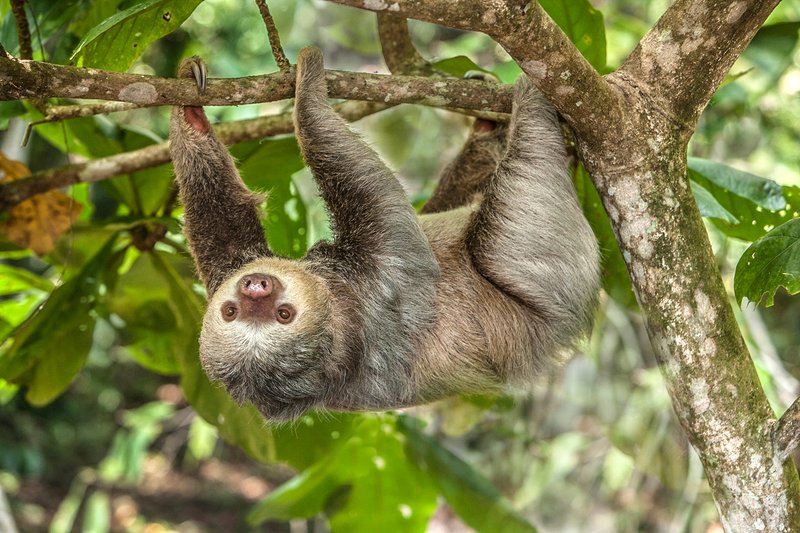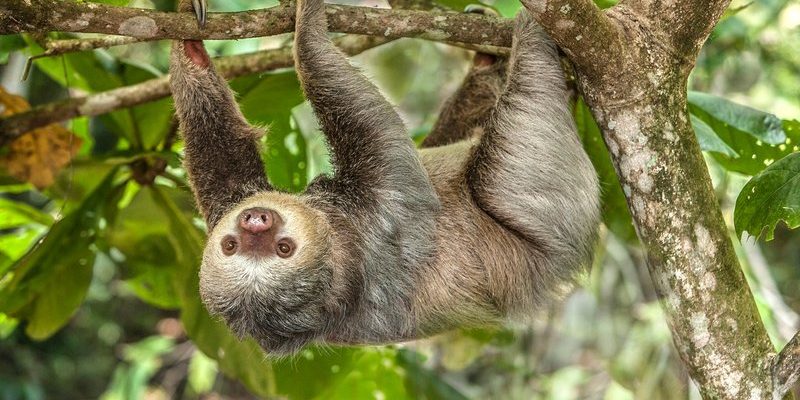
These creatures might look like they’re in a constant state of relaxation, but their way of life is a complex, fascinating adaptation to their environment. Each fun fact displays just how remarkable these seemingly simple animals can be. So, grab a comfy chair, and let’s explore the top ten amazing facts about the two-toed sloth!
1. They’re Not All That Slow
You might think that sloths are all about slow-moving. However, the two-toed sloth can move surprisingly quickly when it needs to! While they usually cruise along at about 0.03 miles per hour (yep, that’s slower than a walking snail!), they can burst into action and move at speeds of up to 2 miles per hour in short sprints.
Imagine a sloth hanging out on a tree branch, munching on some leaves, and then suddenly needing to escape a predator. In that moment, it’s like they transform into a ninja! The truth is, their slow pace is a survival tactic to avoid detection by predators, but they have the ability to move faster when push comes to shove.
2. They Have a Unique Diet
The two-toed sloth has a pretty selective palate. They mainly chow down on leaves, but they have a very specific preference: tender, young leaves from certain trees. Their diet is low in calories, which is just one of the reasons they take their sweet time moving around.
Here’s why this matters: Sloths have a very slow metabolism—like, you might feel guilty about your own slow mornings after hearing about theirs. It can take them up to a month to digest a single meal! This slow digestion supports their energy-efficient lifestyle. Think of it like this: they’re the ultimate meal preppers of the animal world, taking everything they eat very seriously.
3. Their Limbs Are Built for Hanging
Two-toed sloths are uniquely adapted for their tree-dwelling lifestyle. Their long limbs and curved claws are perfect for hanging around in their forest homes. With claws that can stretch up to four inches, they can grip tree branches with ease, allowing them to hang upside down for long periods.
And here’s the kicker: most of their vital organs are positioned differently than in most animals. For example, their heart and lungs sit lower in their bodies. This is smart evolution at work, as it helps them breathe and function properly even while they’re upside down. So, the next time you see a sloth hanging out, remember: they’re fully wired to live that way!
4. They’re Pretty Good Swimmers
It might seem surprising, but two-toed sloths are excellent swimmers! They can move through water at a surprising pace, even faster than they walk on land. They use their long arms to paddle, which can help them cross rivers or find new trees during rainy seasons.
Can you imagine a swimming sloth? It’s a fun image, isn’t it? This skill is crucial in the dense rainforests, where rivers and streams often cut through their habitat. So, if you ever find yourself in the Amazon rainforest, keep an eye out for these leisurely swimmers!
5. They Have a Unique Defense Mechanism
When it comes to avoiding predators, two-toed sloths have a pretty interesting strategy. Instead of running or climbing rapidly to escape, these sloths rely on their camouflage. Their fur often hosts green algae, which helps them blend into the trees and vegetation around them. This makes it a lot harder for predators to spot them.
Additionally, their slow movements mean they don’t draw much attention. Picture this: a sloth hanging on a tree branch, barely moving—almost like it’s just part of the scenery. This unique aspect of their lifestyle shows just how finely attuned sloths are to living in a world filled with threats.
6. Their Reproductive Habits Are Fascinating
Two-toed sloths have a pretty unique approach to reproduction, as well. Mating typically occurs during the rainy season, and the female sloth gives birth to a single baby after a gestation period of about six months. The young sloth clings to its mother’s belly, where it stays safe and secure while learning the ropes of sloth life.
Interestingly, baby sloths are born with their eyes open, and they start to use their limbs almost right away. It’s a heartwarming image to picture a tiny sloth, clinging to its mom, while she expertly climbs through the trees.
7. They Have a Long Lifespan
You might be surprised to learn that two-toed sloths can live quite a long time. In the wild, they can live up to 20 years, while those in captivity can live even longer—sometimes reaching over 30 years. Their slow lifestyle contributes to this longevity, as they face fewer dangers compared to faster animals.
Think of them like the wise old sages of the rainforest, slowly moving along the branches while soaking up their surroundings. The longer they live, the more stories they could tell about their adventures up in the treetops!
8. They’re Not Just Lazy, They’re Energy Savers
You might be wondering why sloths move so slowly, and the answer is all about energy conservation. Their low-calorie diet and slow metabolism mean they have to be careful with their energy use. In fact, they sleep about 15 to 20 hours a day!
This energy-saving strategy is a clever adaptation to their environment. By conserving energy, sloths can survive on their limited diet without needing to expend a lot of energy searching for food. Here’s the thing: being slow isn’t laziness; it’s a smart survival strategy for the sloth.
9. They Have a Specialized Digestive System
As herbivores, two-toed sloths have digestive systems built to handle their specialized diet. Their stomachs are divided into multiple chambers, which allows them to break down tough plant material.
What’s particularly interesting is that they have a symbiotic relationship with bacteria in their guts. This bacteria helps ferment the plant material, making it easier for the sloth to absorb the nutrients it needs. It’s a perfect example of how nature works together in harmony!
10. Sloths Are in Danger
Unfortunately, two-toed sloths are facing some serious threats. Habitat loss due to deforestation is a major issue, as their homes in the rainforests are being destroyed for agriculture and development. They’re also at risk due to climate change and poaching.
Here’s the thing: every effort counts when it comes to protecting these lovely creatures. By raising awareness and supporting conservation efforts, we can help ensure that future generations will have the chance to appreciate the wonders of two-toed sloths.
In conclusion, the two-toed sloth is an incredible animal full of surprises. From their unique dietary habits to their clever survival strategies, there’s a lot more to these creatures than meets the eye. They remind us that sometimes, it’s okay to take life slowly, enjoy the moment, and just hang around. So next time you think about sloths, remember these fascinating facts and appreciate the beauty of one of nature’s quirkiest creatures!

